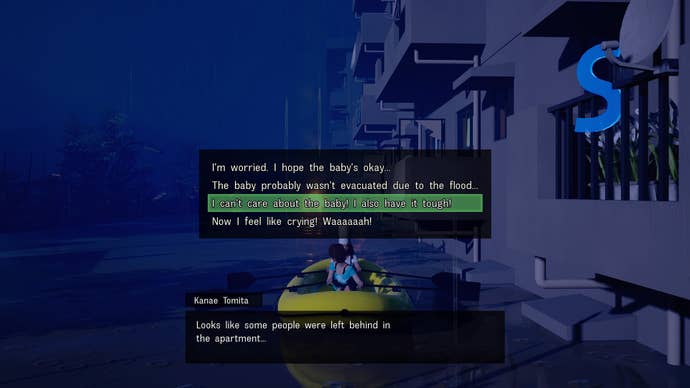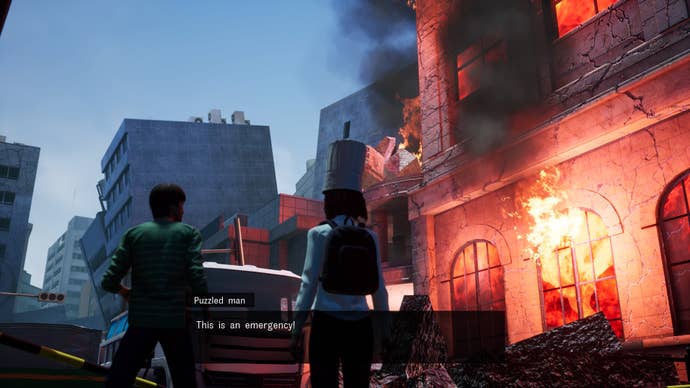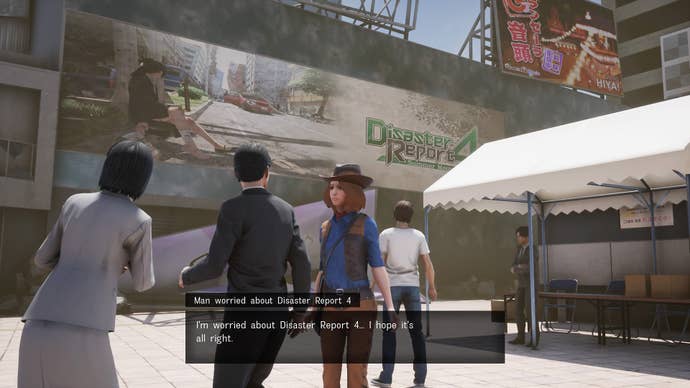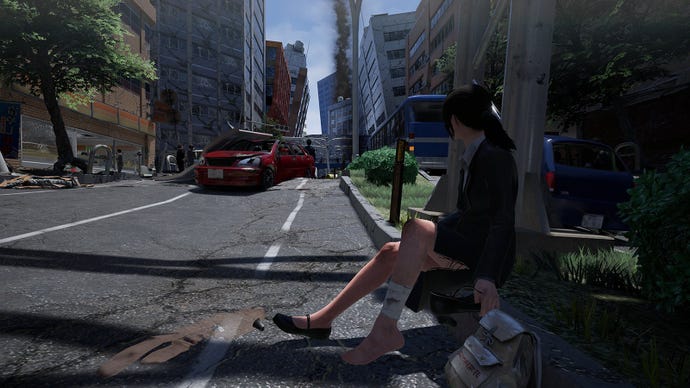Disaster Report 4: Summer Memories Review: A Disaster of Its Own Making
Disaster Report returns to the West, only now it's without what made the oddball series special in the first place.
This article first appeared on USgamer, a partner publication of VG247. Some content, such as this article, has been migrated to VG247 for posterity after USgamer's closure - but it has not been edited or further vetted by the VG247 team.
I can't think of a worse time for Disaster Report 4: Summer Memories to finally release in the West. The world is uneasy as we weather our own disaster, with a pandemic ravaging the world. In Disaster Report 4, citizens of a faux Tokyo city—complete with a Shibuya Crossing look-alike—try to survive the aftermath of their own disaster: a massive earthquake and its many aftershocks, as the city around them crumbles.
Disaster Report 4's very existence is sort of a disaster of its own. Originally developed as a PlayStation 3 title, it was set for release in spring 2011 after being delayed from 2010. Then, the devastating 2011 T?hoku earthquake and tsunami hit Japan—cruelly ironic. Disaster Report 4 was then canceled entirely. Later, Irem, the studio behind the Disaster Report series, pivoted to developing pachinko and slot machines, and series producer and designer Kazuma Kujo left to found Granzella, subsequently acquiring the Disaster Report IP in 2014. The canceled Disaster Report 4 was resurrected thanks to Granzella, where it was re-announced in 2015 as a PlayStation 4 game with PlayStation VR capabilities. (Note: Due to not owning a PSVR headset, we were not able to play the VR option for our review.)

Playing it in 2020, nearly two years after its debut in Japan, it feels like it's been dragged against its will across generations. The series began in 2002 back on PlayStation 2, coming to North America just a year later. Its sequel, the fun and quirky Raw Danger, followed it four years later. The third, PSP-exclusive game in the series never made its way westward, but now, 13 years after Raw Danger's release in the U.S., we at last have Disaster Report 4. In essence, it's a PlayStation 2 game wrapped in PlayStation 3 graphics trapped in a PlayStation 4 game's body.
So it's janky, to say the very least. Facial animations are stiff; movement is stiff. The status effects—hunger, thirst, stress, and a need to use the toilet—are mostly negligible "survival" elements. At one point I resisted using the restroom for several hours, and the biggest consequence was that when my character stood still, she would cross her legs together like she had to go pee. The PlayStation 2 roots are apparent in its frequent load screens when transitioning between areas, even just in opening a door. In busy areas, whether full of architectural chaos or NPCs, the frame rate slows to a crawl. I can't even imagine how poorly this must perform on Switch if it's this bad on PlayStation 4 Pro.
Environments are hard to read too. Throughout Disaster Report 4, I found myself in dozens of situations where I had no idea how to progress or where to go. I invariably failed to spot some hard-to-see crawlspace or climbable box, or missed that I had to talk to certain people in a particular order to trigger the appearance of an interactive item. It's annoyances like these that held me back from progressing the story at a normal pace.

Still, for all its technical faults, the structure of Disaster Report 4 remains novel and charming in its own right. In one moment, it's an action-adventure as you flee the chaos of crumbling buildings; the next it's almost a visual novel thanks to its surplus of dialogue options. There are haunting moments that work as intended; like walking up to a ferry dock to board a rescue boat, only for an aftershock to occur that sends a group of citizens falling into the ocean screaming, as I run the opposite direction to avoid the crumbling concrete. In these moments, it's horrifying and affecting.
Disaster Report 4 is more serious than its far campier predecessors, as if it has a lot on its mind in wrestling with the realities of Japan's own T?hoku earthquake. It's a game that tries to be aware of how folks respond to turmoil, where some take advantage of the chaos and use it for their own gain—like a man impersonating a convenience store manager to charge exorbitant rates for goods—and others who come together and help one another out. It's the familiar archetypal tropes of any disaster media, but in Disaster Report 4 they're sometimes endearing, and even uncomfortable at times.
It still retains moments of levity, from the collectable compasses to the plentiful clothes, such as my favorite full cowboy get-up. (Yee-haw!) There are enjoyable moments of comedy that don't detract from the more serious story beats, like an extended subplot that culminates in a man asking what I wanted in return for doing this favor for him, and I got the option to literally change the name of the game. I decided to change it to Disaster Report 5, and my save file and loading screens from that point onward had an orange "Disaster Report 5: ?" logo.
However, there's a chief underlying problem with Disaster Report 4: no particular character is really memorable. There's a familiar character from past entries who makes an appearance early on, but she's ultimately just "the teacher you meet at the start who cares about her students, even though two of them are total bullies." Then there's the woman saved from a crumbling building; and later, a woman named Kanae who is saved from debris in a subway station. (Catch a pattern here?)
The most memorable character is really the one I sculpted, thanks to the in-game character customization (a first for the series) and dialogue options. It's very obvious the writers only wrote with a male protagonist in mind though. Initially, I found it cool that it allowed me to flirt with women as a woman, and then I realized what was really going on when character after character treated me like a man. Oh, and when it let me use a urinal to go to the bathroom.
At Disaster Report 4's best, it's almost Yakuza-like, aptly balancing absurdity with compassionate storytelling, even if its characters are mostly forgettable. Though at its worst, it just feels gross and exploitative.
A lot this boils down to the fates of my companions. For example, early on, my companion Kanae and I were tied up by two drunk men in an empty subway station who were threatening to rape her—this was maybe five minutes after I rescued her from some rubble, mind you. And after enduring a truly broken stealth sequence of crawling our way to freedom, my character got the option to hit on Kanae, despite her mentioning her boyfriend recently and, well, the horrifying situation we just went through. And that's the least distasteful instance. It may be seen in the developers' eyes as another example of evil people taking advantage of others in tragic circumstances, but the sequences are just gratuitous.

In its pursuit to be everything at once, Disaster Report 4 misses what made the series resonate in the first place. Its campy tone is obscured in favor of a more serious bend that only works a small percentage of the time. Mechanically and performance-wise, it's a mess. Days removed from wrapping up my trek through not-but-totally Tokyo, it's the entertaining ludicrous moments that I'll remember—from a brief jaunt with a disaster cult to my absolutely not-disaster appropriate cowboy hat. Not even Disaster Report 4's bonkers (and underbaked) ending could save it. The boredom, tedium, and disgust I experienced otherwise far outweighed the handful of silly highs peppered through.
It's been weird to play Disaster Report 4 in light of everything that's going on in the world. I'm surprised that now, in the midst of a pandemic, the disaster game we've been waiting to play for nearly a decade is here. Even in-game, NPCs act surprised at the fact that Disaster Report 4 exists—there are in-game posters everywhere, and one NPC even references its doomed release.
And now, all I can think is: Maybe Disaster Report 4 should have stayed doomed.
ConclusionFor Disaster Report's grand return to the West, Disaster Report 4 puts its focus on humanity struggling for survival amidst the destruction. And it's here, that is unfortunately its greatest misstep, with long stretches of tedium and even moments that feel exploitative. In paring down the campy charm of the series before it, Disaster Report 4's more serious tone often crumbles like the very buildings you find yourself running away from.


